Strategic Management: Approaches, SWOT, and Innovation for Growth
VerifiedAdded on 2023/06/09
|9
|3046
|358
Report
AI Summary
This report provides an overview of strategic management, including a comparison of prescriptive and emergent approaches to strategy, the use of SWOT analysis, and the role of innovation in long-term organizational development. It highlights the importance of strategic planning in achieving organizational goals and maintaining a competitive advantage. The report also evaluates the benefits, costs, and risks associated with using innovation to drive organizational growth, providing examples of how this approach works in practice. Desklib is a platform where students can find similar solved assignments and resources.
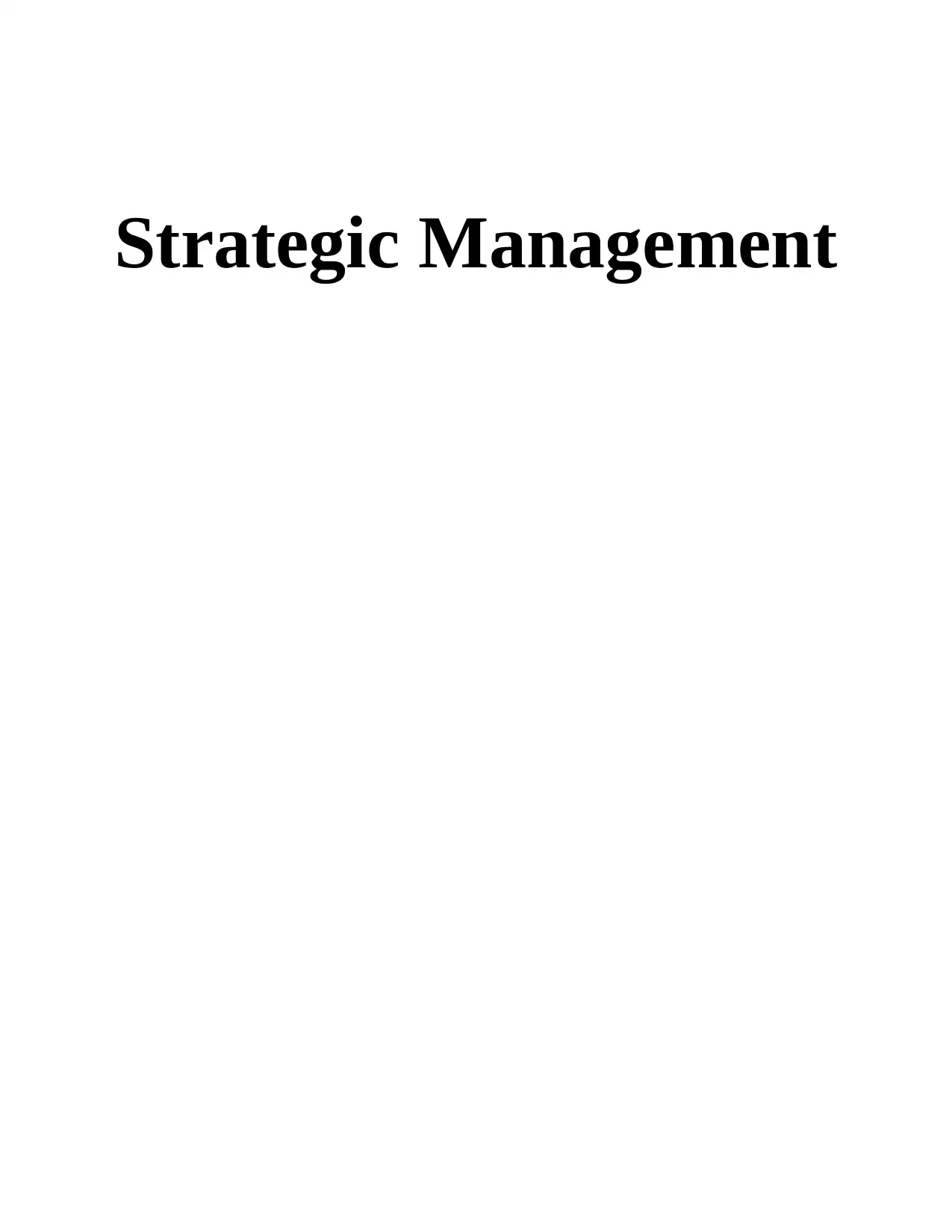
Strategic Management
Paraphrase This Document
Need a fresh take? Get an instant paraphrase of this document with our AI Paraphraser
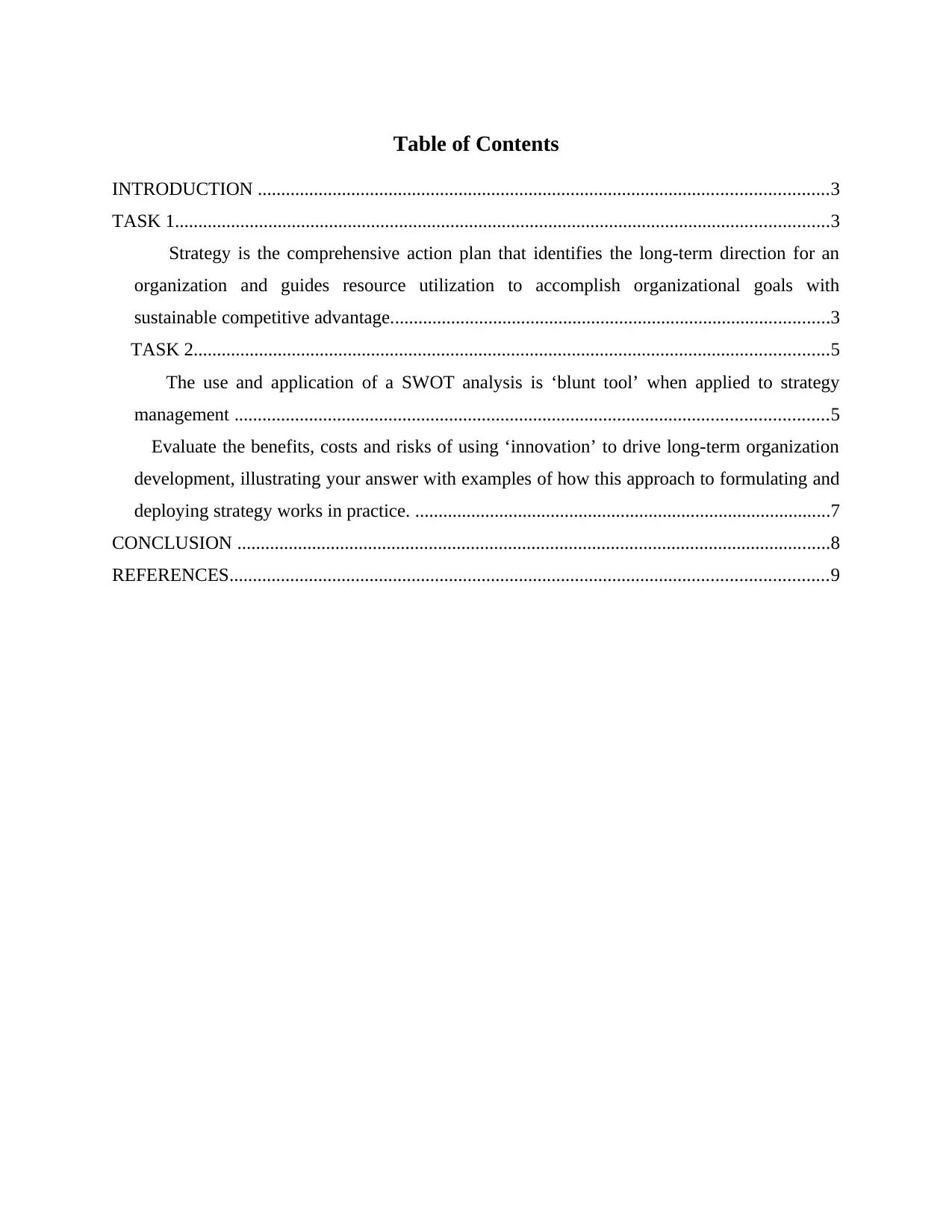
Table of Contents
INTRODUCTION ..........................................................................................................................3
TASK 1............................................................................................................................................3
Strategy is the comprehensive action plan that identifies the long-term direction for an
organization and guides resource utilization to accomplish organizational goals with
sustainable competitive advantage..............................................................................................3
TASK 2........................................................................................................................................5
The use and application of a SWOT analysis is ‘blunt tool’ when applied to strategy
management ...............................................................................................................................5
Evaluate the benefits, costs and risks of using ‘innovation’ to drive long-term organization
development, illustrating your answer with examples of how this approach to formulating and
deploying strategy works in practice. .........................................................................................7
CONCLUSION ...............................................................................................................................8
REFERENCES................................................................................................................................9
INTRODUCTION ..........................................................................................................................3
TASK 1............................................................................................................................................3
Strategy is the comprehensive action plan that identifies the long-term direction for an
organization and guides resource utilization to accomplish organizational goals with
sustainable competitive advantage..............................................................................................3
TASK 2........................................................................................................................................5
The use and application of a SWOT analysis is ‘blunt tool’ when applied to strategy
management ...............................................................................................................................5
Evaluate the benefits, costs and risks of using ‘innovation’ to drive long-term organization
development, illustrating your answer with examples of how this approach to formulating and
deploying strategy works in practice. .........................................................................................7
CONCLUSION ...............................................................................................................................8
REFERENCES................................................................................................................................9

INTRODUCTION
Strategic management can be defined as the continuos analysis and assessment of the
organisation in terms of planning and organising to generate the desired goals and the objectives.
It is the process that identify the strategies that affects the organisation in its working and
generate the positive results and after that implementation of those strategies for the better
outcome. These strategies can be carry out for better performance and to get the competitive
advantage in the market. It contains the set of decisions which can be implemented after the
whole analysis of the organisation in context of which decisions generates better results in firm's
performance(Dzwigol, 2020) . The aim of the report is to highlight the strategies that creates the
detail action plan that needs to be implement for the long term organisational goal with the
SWOT analysis as a blunt tool for strategy management. And at last it contains the discussion on
the benefits, costs and risks of using innovation to get long term organisational development.
TASK 1
Strategy is the comprehensive action plan that identifies the long-term direction for an
organization and guides resource utilization to accomplish organizational goals with
sustainable competitive advantage.
Critically compare and contrast the application of ‘prescriptive’ and ‘emergent’
approaches to strategy and outline their role in the delivery of this aim. Where possible use
examples drawn from the literature to support points you put forward.
Strategic planning is refers to a tool that provides direction to the business for the better
performance for the success. Strategies unify teams in a single unit and gives them direction for
taking tough business decisions (Gobble, 2018). To identify the or implement the strategies
there is a need for a complete action plan which includes various steps that needs to follow that
are , firstly organisation need to define their vision, it is required to develop the what company
needs to achieve in the future and what are there goals. In the second stage it contains the
personal objectives that are relate to the company that also needs to generate from the different
strategies. In the third step it includes the knowledge of the organisation, in consist analysis of
the organisation on the basis of its strengths , weaknesses , threat and the opportunities. After
that in includes creation of the short term goals that helps in a way to achieve long term goals ,
Strategic management can be defined as the continuos analysis and assessment of the
organisation in terms of planning and organising to generate the desired goals and the objectives.
It is the process that identify the strategies that affects the organisation in its working and
generate the positive results and after that implementation of those strategies for the better
outcome. These strategies can be carry out for better performance and to get the competitive
advantage in the market. It contains the set of decisions which can be implemented after the
whole analysis of the organisation in context of which decisions generates better results in firm's
performance(Dzwigol, 2020) . The aim of the report is to highlight the strategies that creates the
detail action plan that needs to be implement for the long term organisational goal with the
SWOT analysis as a blunt tool for strategy management. And at last it contains the discussion on
the benefits, costs and risks of using innovation to get long term organisational development.
TASK 1
Strategy is the comprehensive action plan that identifies the long-term direction for an
organization and guides resource utilization to accomplish organizational goals with
sustainable competitive advantage.
Critically compare and contrast the application of ‘prescriptive’ and ‘emergent’
approaches to strategy and outline their role in the delivery of this aim. Where possible use
examples drawn from the literature to support points you put forward.
Strategic planning is refers to a tool that provides direction to the business for the better
performance for the success. Strategies unify teams in a single unit and gives them direction for
taking tough business decisions (Gobble, 2018). To identify the or implement the strategies
there is a need for a complete action plan which includes various steps that needs to follow that
are , firstly organisation need to define their vision, it is required to develop the what company
needs to achieve in the future and what are there goals. In the second stage it contains the
personal objectives that are relate to the company that also needs to generate from the different
strategies. In the third step it includes the knowledge of the organisation, in consist analysis of
the organisation on the basis of its strengths , weaknesses , threat and the opportunities. After
that in includes creation of the short term goals that helps in a way to achieve long term goals ,
⊘ This is a preview!⊘
Do you want full access?
Subscribe today to unlock all pages.

Trusted by 1+ million students worldwide
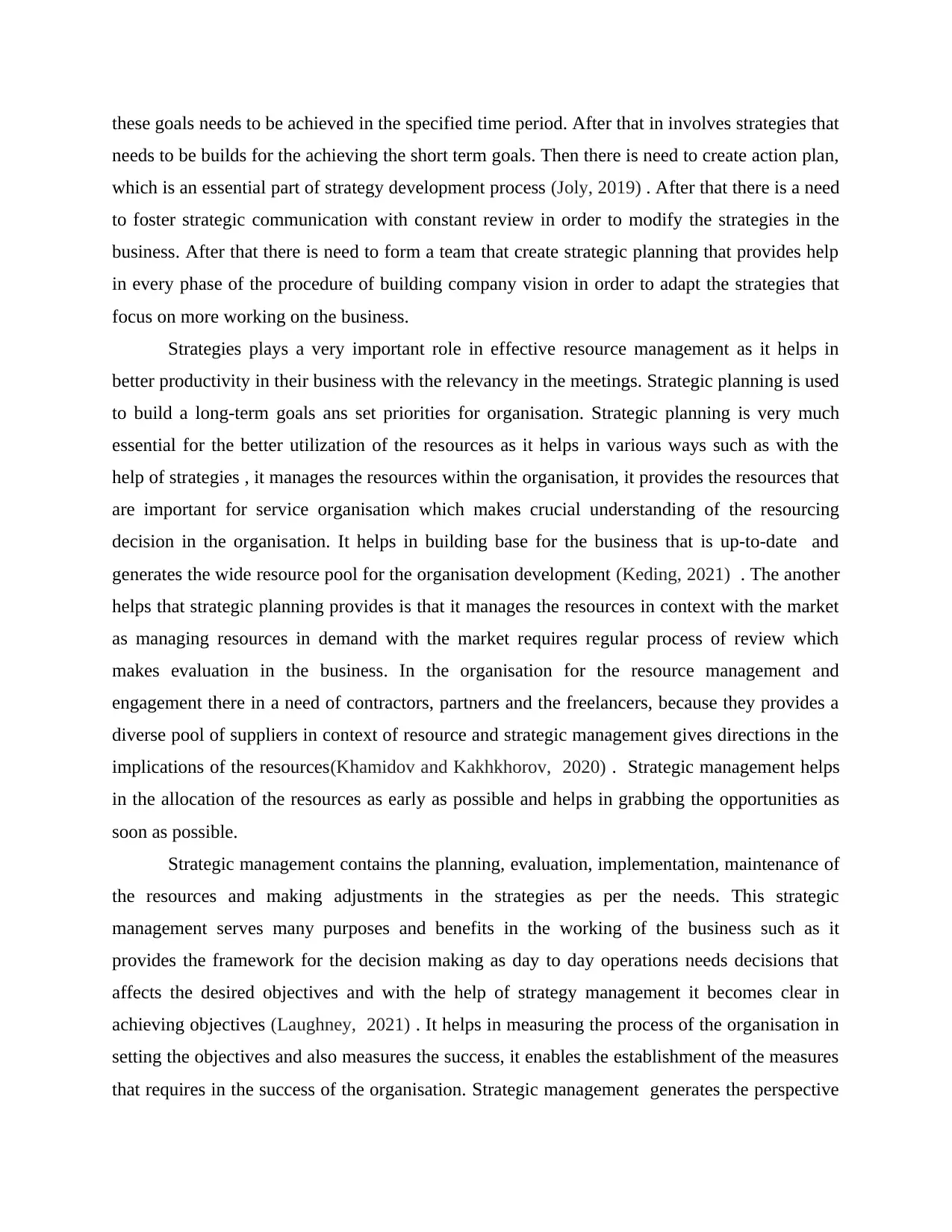
these goals needs to be achieved in the specified time period. After that in involves strategies that
needs to be builds for the achieving the short term goals. Then there is need to create action plan,
which is an essential part of strategy development process (Joly, 2019) . After that there is a need
to foster strategic communication with constant review in order to modify the strategies in the
business. After that there is need to form a team that create strategic planning that provides help
in every phase of the procedure of building company vision in order to adapt the strategies that
focus on more working on the business.
Strategies plays a very important role in effective resource management as it helps in
better productivity in their business with the relevancy in the meetings. Strategic planning is used
to build a long-term goals ans set priorities for organisation. Strategic planning is very much
essential for the better utilization of the resources as it helps in various ways such as with the
help of strategies , it manages the resources within the organisation, it provides the resources that
are important for service organisation which makes crucial understanding of the resourcing
decision in the organisation. It helps in building base for the business that is up-to-date and
generates the wide resource pool for the organisation development (Keding, 2021) . The another
helps that strategic planning provides is that it manages the resources in context with the market
as managing resources in demand with the market requires regular process of review which
makes evaluation in the business. In the organisation for the resource management and
engagement there in a need of contractors, partners and the freelancers, because they provides a
diverse pool of suppliers in context of resource and strategic management gives directions in the
implications of the resources(Khamidov and Kakhkhorov, 2020) . Strategic management helps
in the allocation of the resources as early as possible and helps in grabbing the opportunities as
soon as possible.
Strategic management contains the planning, evaluation, implementation, maintenance of
the resources and making adjustments in the strategies as per the needs. This strategic
management serves many purposes and benefits in the working of the business such as it
provides the framework for the decision making as day to day operations needs decisions that
affects the desired objectives and with the help of strategy management it becomes clear in
achieving objectives (Laughney, 2021) . It helps in measuring the process of the organisation in
setting the objectives and also measures the success, it enables the establishment of the measures
that requires in the success of the organisation. Strategic management generates the perspective
needs to be builds for the achieving the short term goals. Then there is need to create action plan,
which is an essential part of strategy development process (Joly, 2019) . After that there is a need
to foster strategic communication with constant review in order to modify the strategies in the
business. After that there is need to form a team that create strategic planning that provides help
in every phase of the procedure of building company vision in order to adapt the strategies that
focus on more working on the business.
Strategies plays a very important role in effective resource management as it helps in
better productivity in their business with the relevancy in the meetings. Strategic planning is used
to build a long-term goals ans set priorities for organisation. Strategic planning is very much
essential for the better utilization of the resources as it helps in various ways such as with the
help of strategies , it manages the resources within the organisation, it provides the resources that
are important for service organisation which makes crucial understanding of the resourcing
decision in the organisation. It helps in building base for the business that is up-to-date and
generates the wide resource pool for the organisation development (Keding, 2021) . The another
helps that strategic planning provides is that it manages the resources in context with the market
as managing resources in demand with the market requires regular process of review which
makes evaluation in the business. In the organisation for the resource management and
engagement there in a need of contractors, partners and the freelancers, because they provides a
diverse pool of suppliers in context of resource and strategic management gives directions in the
implications of the resources(Khamidov and Kakhkhorov, 2020) . Strategic management helps
in the allocation of the resources as early as possible and helps in grabbing the opportunities as
soon as possible.
Strategic management contains the planning, evaluation, implementation, maintenance of
the resources and making adjustments in the strategies as per the needs. This strategic
management serves many purposes and benefits in the working of the business such as it
provides the framework for the decision making as day to day operations needs decisions that
affects the desired objectives and with the help of strategy management it becomes clear in
achieving objectives (Laughney, 2021) . It helps in measuring the process of the organisation in
setting the objectives and also measures the success, it enables the establishment of the measures
that requires in the success of the organisation. Strategic management generates the perspective
Paraphrase This Document
Need a fresh take? Get an instant paraphrase of this document with our AI Paraphraser
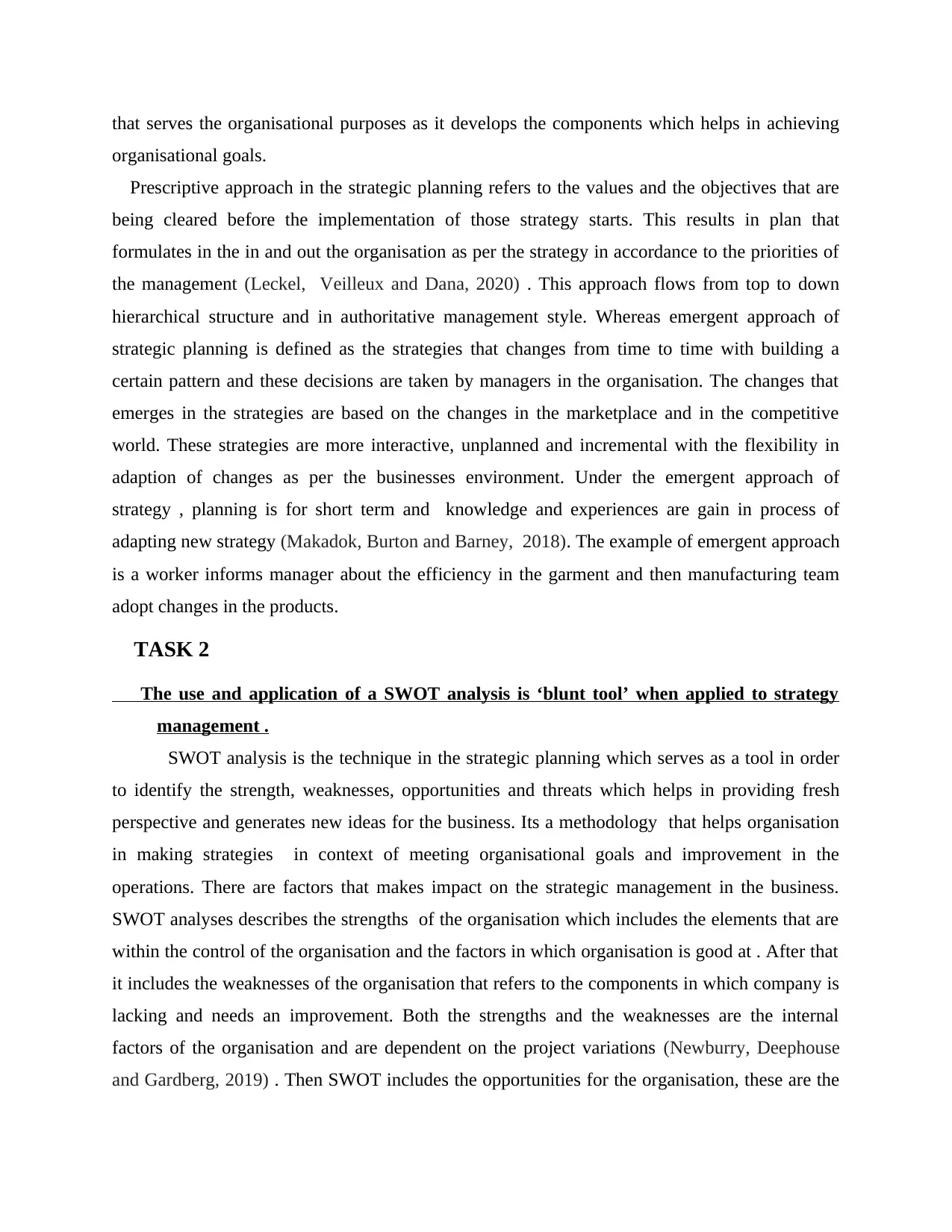
that serves the organisational purposes as it develops the components which helps in achieving
organisational goals.
Prescriptive approach in the strategic planning refers to the values and the objectives that are
being cleared before the implementation of those strategy starts. This results in plan that
formulates in the in and out the organisation as per the strategy in accordance to the priorities of
the management (Leckel, Veilleux and Dana, 2020) . This approach flows from top to down
hierarchical structure and in authoritative management style. Whereas emergent approach of
strategic planning is defined as the strategies that changes from time to time with building a
certain pattern and these decisions are taken by managers in the organisation. The changes that
emerges in the strategies are based on the changes in the marketplace and in the competitive
world. These strategies are more interactive, unplanned and incremental with the flexibility in
adaption of changes as per the businesses environment. Under the emergent approach of
strategy , planning is for short term and knowledge and experiences are gain in process of
adapting new strategy (Makadok, Burton and Barney, 2018). The example of emergent approach
is a worker informs manager about the efficiency in the garment and then manufacturing team
adopt changes in the products.
TASK 2
The use and application of a SWOT analysis is ‘blunt tool’ when applied to strategy
management .
SWOT analysis is the technique in the strategic planning which serves as a tool in order
to identify the strength, weaknesses, opportunities and threats which helps in providing fresh
perspective and generates new ideas for the business. Its a methodology that helps organisation
in making strategies in context of meeting organisational goals and improvement in the
operations. There are factors that makes impact on the strategic management in the business.
SWOT analyses describes the strengths of the organisation which includes the elements that are
within the control of the organisation and the factors in which organisation is good at . After that
it includes the weaknesses of the organisation that refers to the components in which company is
lacking and needs an improvement. Both the strengths and the weaknesses are the internal
factors of the organisation and are dependent on the project variations (Newburry, Deephouse
and Gardberg, 2019) . Then SWOT includes the opportunities for the organisation, these are the
organisational goals.
Prescriptive approach in the strategic planning refers to the values and the objectives that are
being cleared before the implementation of those strategy starts. This results in plan that
formulates in the in and out the organisation as per the strategy in accordance to the priorities of
the management (Leckel, Veilleux and Dana, 2020) . This approach flows from top to down
hierarchical structure and in authoritative management style. Whereas emergent approach of
strategic planning is defined as the strategies that changes from time to time with building a
certain pattern and these decisions are taken by managers in the organisation. The changes that
emerges in the strategies are based on the changes in the marketplace and in the competitive
world. These strategies are more interactive, unplanned and incremental with the flexibility in
adaption of changes as per the businesses environment. Under the emergent approach of
strategy , planning is for short term and knowledge and experiences are gain in process of
adapting new strategy (Makadok, Burton and Barney, 2018). The example of emergent approach
is a worker informs manager about the efficiency in the garment and then manufacturing team
adopt changes in the products.
TASK 2
The use and application of a SWOT analysis is ‘blunt tool’ when applied to strategy
management .
SWOT analysis is the technique in the strategic planning which serves as a tool in order
to identify the strength, weaknesses, opportunities and threats which helps in providing fresh
perspective and generates new ideas for the business. Its a methodology that helps organisation
in making strategies in context of meeting organisational goals and improvement in the
operations. There are factors that makes impact on the strategic management in the business.
SWOT analyses describes the strengths of the organisation which includes the elements that are
within the control of the organisation and the factors in which organisation is good at . After that
it includes the weaknesses of the organisation that refers to the components in which company is
lacking and needs an improvement. Both the strengths and the weaknesses are the internal
factors of the organisation and are dependent on the project variations (Newburry, Deephouse
and Gardberg, 2019) . Then SWOT includes the opportunities for the organisation, these are the
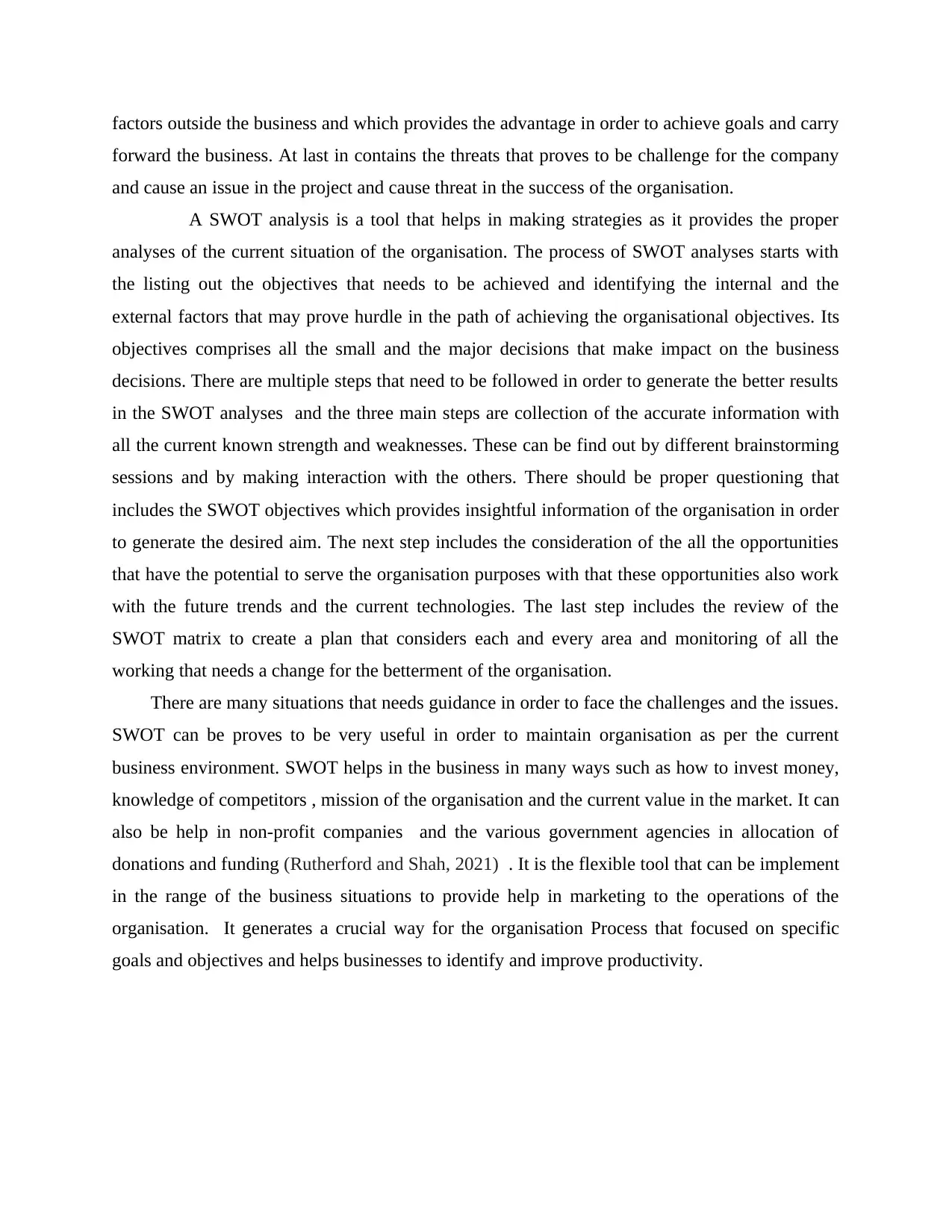
factors outside the business and which provides the advantage in order to achieve goals and carry
forward the business. At last in contains the threats that proves to be challenge for the company
and cause an issue in the project and cause threat in the success of the organisation.
A SWOT analysis is a tool that helps in making strategies as it provides the proper
analyses of the current situation of the organisation. The process of SWOT analyses starts with
the listing out the objectives that needs to be achieved and identifying the internal and the
external factors that may prove hurdle in the path of achieving the organisational objectives. Its
objectives comprises all the small and the major decisions that make impact on the business
decisions. There are multiple steps that need to be followed in order to generate the better results
in the SWOT analyses and the three main steps are collection of the accurate information with
all the current known strength and weaknesses. These can be find out by different brainstorming
sessions and by making interaction with the others. There should be proper questioning that
includes the SWOT objectives which provides insightful information of the organisation in order
to generate the desired aim. The next step includes the consideration of the all the opportunities
that have the potential to serve the organisation purposes with that these opportunities also work
with the future trends and the current technologies. The last step includes the review of the
SWOT matrix to create a plan that considers each and every area and monitoring of all the
working that needs a change for the betterment of the organisation.
There are many situations that needs guidance in order to face the challenges and the issues.
SWOT can be proves to be very useful in order to maintain organisation as per the current
business environment. SWOT helps in the business in many ways such as how to invest money,
knowledge of competitors , mission of the organisation and the current value in the market. It can
also be help in non-profit companies and the various government agencies in allocation of
donations and funding (Rutherford and Shah, 2021) . It is the flexible tool that can be implement
in the range of the business situations to provide help in marketing to the operations of the
organisation. It generates a crucial way for the organisation Process that focused on specific
goals and objectives and helps businesses to identify and improve productivity.
forward the business. At last in contains the threats that proves to be challenge for the company
and cause an issue in the project and cause threat in the success of the organisation.
A SWOT analysis is a tool that helps in making strategies as it provides the proper
analyses of the current situation of the organisation. The process of SWOT analyses starts with
the listing out the objectives that needs to be achieved and identifying the internal and the
external factors that may prove hurdle in the path of achieving the organisational objectives. Its
objectives comprises all the small and the major decisions that make impact on the business
decisions. There are multiple steps that need to be followed in order to generate the better results
in the SWOT analyses and the three main steps are collection of the accurate information with
all the current known strength and weaknesses. These can be find out by different brainstorming
sessions and by making interaction with the others. There should be proper questioning that
includes the SWOT objectives which provides insightful information of the organisation in order
to generate the desired aim. The next step includes the consideration of the all the opportunities
that have the potential to serve the organisation purposes with that these opportunities also work
with the future trends and the current technologies. The last step includes the review of the
SWOT matrix to create a plan that considers each and every area and monitoring of all the
working that needs a change for the betterment of the organisation.
There are many situations that needs guidance in order to face the challenges and the issues.
SWOT can be proves to be very useful in order to maintain organisation as per the current
business environment. SWOT helps in the business in many ways such as how to invest money,
knowledge of competitors , mission of the organisation and the current value in the market. It can
also be help in non-profit companies and the various government agencies in allocation of
donations and funding (Rutherford and Shah, 2021) . It is the flexible tool that can be implement
in the range of the business situations to provide help in marketing to the operations of the
organisation. It generates a crucial way for the organisation Process that focused on specific
goals and objectives and helps businesses to identify and improve productivity.
⊘ This is a preview!⊘
Do you want full access?
Subscribe today to unlock all pages.

Trusted by 1+ million students worldwide

Evaluate the benefits, costs and risks of using ‘innovation’ to drive long-term
organization development, illustrating your answer with examples of how this
approach to formulating and deploying strategy works in practice.
Innovation in the business refers to the new processes and services that are introduces by
the organization or in terms of products to make changes in the business. Innovation provides
various benefits to the organization that helps to foster growth in order to stand in the
competition. The benefits that innovation generates to the business are it improved the
productivity in the employees as innovation provides multiple technology that makes the work
easy(Sam, Ramprasad and Koteswara Prasad,2021). It helps in reduce the cost of the production
and promotion. Innovation also helps in making improvement in the brand recognition and gives
value to it. For the long term Growth in the business it is very important for the it to solve the
problems that arises in the business and many times problems create hurdles in the success of the
company and innovation provides the ways to solve problems easily. To be in the market, there
is a need to change according to the needs of the market and in order to make changes in the
business there is a huge need of innovation in the company. And with the helps of the innovation
its being easy to beat the competitors easily as innovation enhances the productivity and
technology.
The process of innovation is the most important in the developing business and in the
competitive market. Companies follows variant of innovation in order to reduce the cost in the
business but innovation is the process that also needed costs. Innovation mainly allocated a
limited amount of the financial resources and its essential in the process of innovation to not to
exceed the budget as this process needed detail plan with the accurate estimation of costs. In
terms to manage the costs there are tool that manages or 4staimates the direct and indirect
expenses. The innovation process needed costs and it becomes important element in the business.
With the benefits and the costs in the process of innovation there is also one element in the
this process which needed to be considered that is risk associated with the innovation process.
There are many risks when an organization introduces new technology in the or innovate
something new such as risk of failure as some times innovation fails to generate the result that
needed to be(Thomas,2019) . To be able to cope up with the current technology in the business
there is a need to change frequently and these small and fast iterations in for more success makes
negative impact on the workforce of the organization. In the process of successful development
organization development, illustrating your answer with examples of how this
approach to formulating and deploying strategy works in practice.
Innovation in the business refers to the new processes and services that are introduces by
the organization or in terms of products to make changes in the business. Innovation provides
various benefits to the organization that helps to foster growth in order to stand in the
competition. The benefits that innovation generates to the business are it improved the
productivity in the employees as innovation provides multiple technology that makes the work
easy(Sam, Ramprasad and Koteswara Prasad,2021). It helps in reduce the cost of the production
and promotion. Innovation also helps in making improvement in the brand recognition and gives
value to it. For the long term Growth in the business it is very important for the it to solve the
problems that arises in the business and many times problems create hurdles in the success of the
company and innovation provides the ways to solve problems easily. To be in the market, there
is a need to change according to the needs of the market and in order to make changes in the
business there is a huge need of innovation in the company. And with the helps of the innovation
its being easy to beat the competitors easily as innovation enhances the productivity and
technology.
The process of innovation is the most important in the developing business and in the
competitive market. Companies follows variant of innovation in order to reduce the cost in the
business but innovation is the process that also needed costs. Innovation mainly allocated a
limited amount of the financial resources and its essential in the process of innovation to not to
exceed the budget as this process needed detail plan with the accurate estimation of costs. In
terms to manage the costs there are tool that manages or 4staimates the direct and indirect
expenses. The innovation process needed costs and it becomes important element in the business.
With the benefits and the costs in the process of innovation there is also one element in the
this process which needed to be considered that is risk associated with the innovation process.
There are many risks when an organization introduces new technology in the or innovate
something new such as risk of failure as some times innovation fails to generate the result that
needed to be(Thomas,2019) . To be able to cope up with the current technology in the business
there is a need to change frequently and these small and fast iterations in for more success makes
negative impact on the workforce of the organization. In the process of successful development
Paraphrase This Document
Need a fresh take? Get an instant paraphrase of this document with our AI Paraphraser
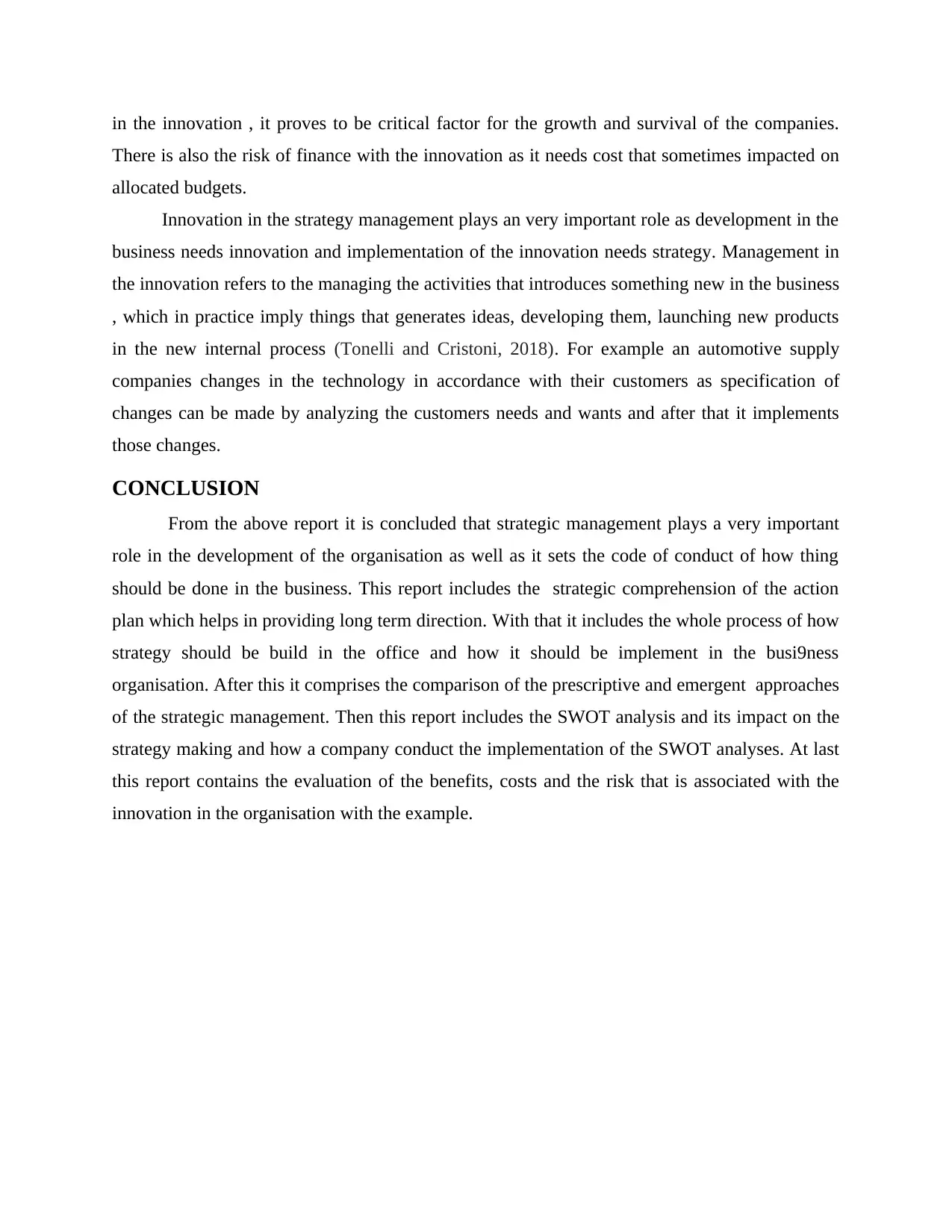
in the innovation , it proves to be critical factor for the growth and survival of the companies.
There is also the risk of finance with the innovation as it needs cost that sometimes impacted on
allocated budgets.
Innovation in the strategy management plays an very important role as development in the
business needs innovation and implementation of the innovation needs strategy. Management in
the innovation refers to the managing the activities that introduces something new in the business
, which in practice imply things that generates ideas, developing them, launching new products
in the new internal process (Tonelli and Cristoni, 2018). For example an automotive supply
companies changes in the technology in accordance with their customers as specification of
changes can be made by analyzing the customers needs and wants and after that it implements
those changes.
CONCLUSION
From the above report it is concluded that strategic management plays a very important
role in the development of the organisation as well as it sets the code of conduct of how thing
should be done in the business. This report includes the strategic comprehension of the action
plan which helps in providing long term direction. With that it includes the whole process of how
strategy should be build in the office and how it should be implement in the busi9ness
organisation. After this it comprises the comparison of the prescriptive and emergent approaches
of the strategic management. Then this report includes the SWOT analysis and its impact on the
strategy making and how a company conduct the implementation of the SWOT analyses. At last
this report contains the evaluation of the benefits, costs and the risk that is associated with the
innovation in the organisation with the example.
There is also the risk of finance with the innovation as it needs cost that sometimes impacted on
allocated budgets.
Innovation in the strategy management plays an very important role as development in the
business needs innovation and implementation of the innovation needs strategy. Management in
the innovation refers to the managing the activities that introduces something new in the business
, which in practice imply things that generates ideas, developing them, launching new products
in the new internal process (Tonelli and Cristoni, 2018). For example an automotive supply
companies changes in the technology in accordance with their customers as specification of
changes can be made by analyzing the customers needs and wants and after that it implements
those changes.
CONCLUSION
From the above report it is concluded that strategic management plays a very important
role in the development of the organisation as well as it sets the code of conduct of how thing
should be done in the business. This report includes the strategic comprehension of the action
plan which helps in providing long term direction. With that it includes the whole process of how
strategy should be build in the office and how it should be implement in the busi9ness
organisation. After this it comprises the comparison of the prescriptive and emergent approaches
of the strategic management. Then this report includes the SWOT analysis and its impact on the
strategy making and how a company conduct the implementation of the SWOT analyses. At last
this report contains the evaluation of the benefits, costs and the risk that is associated with the
innovation in the organisation with the example.
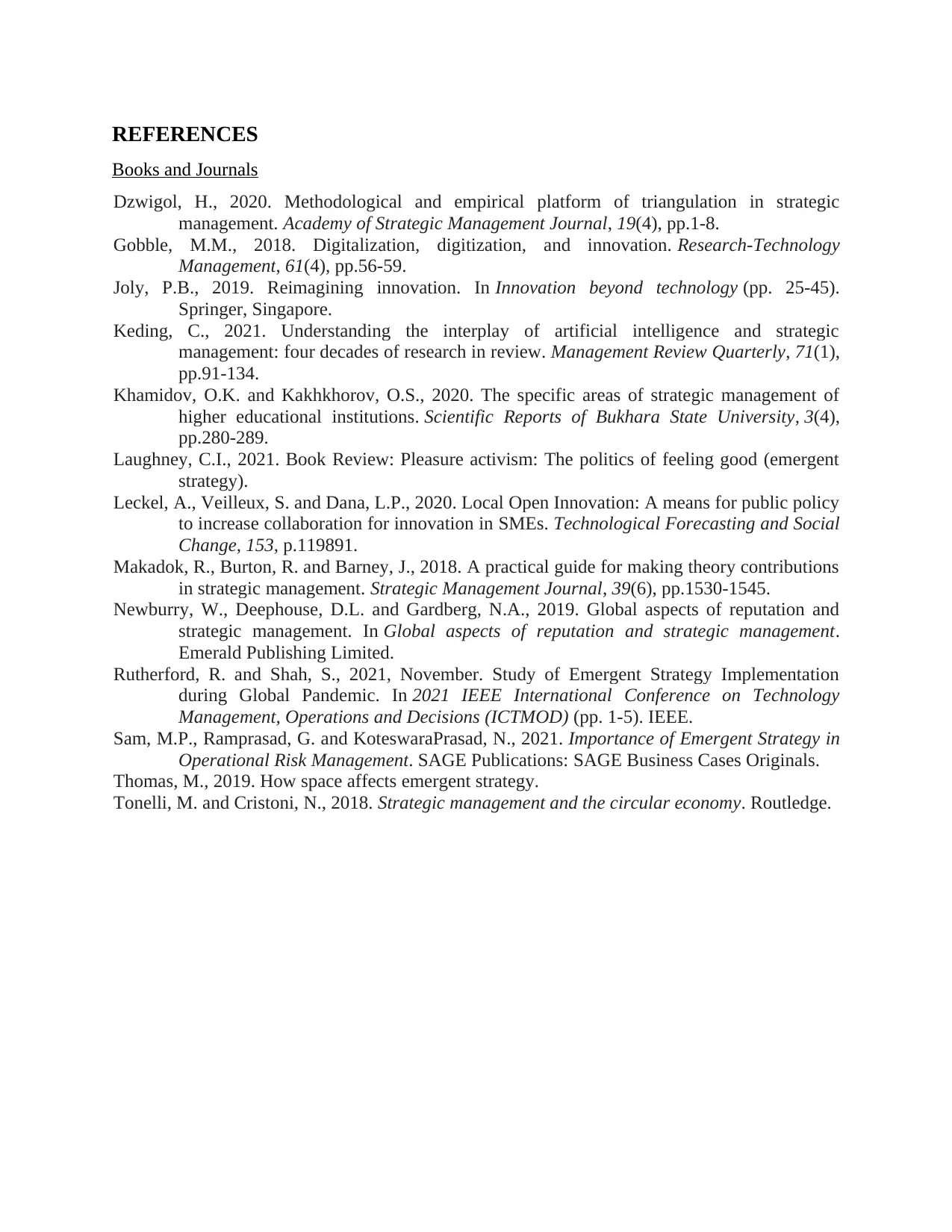
REFERENCES
Books and Journals
Dzwigol, H., 2020. Methodological and empirical platform of triangulation in strategic
management. Academy of Strategic Management Journal, 19(4), pp.1-8.
Gobble, M.M., 2018. Digitalization, digitization, and innovation. Research-Technology
Management, 61(4), pp.56-59.
Joly, P.B., 2019. Reimagining innovation. In Innovation beyond technology (pp. 25-45).
Springer, Singapore.
Keding, C., 2021. Understanding the interplay of artificial intelligence and strategic
management: four decades of research in review. Management Review Quarterly, 71(1),
pp.91-134.
Khamidov, O.K. and Kakhkhorov, O.S., 2020. The specific areas of strategic management of
higher educational institutions. Scientific Reports of Bukhara State University, 3(4),
pp.280-289.
Laughney, C.I., 2021. Book Review: Pleasure activism: The politics of feeling good (emergent
strategy).
Leckel, A., Veilleux, S. and Dana, L.P., 2020. Local Open Innovation: A means for public policy
to increase collaboration for innovation in SMEs. Technological Forecasting and Social
Change, 153, p.119891.
Makadok, R., Burton, R. and Barney, J., 2018. A practical guide for making theory contributions
in strategic management. Strategic Management Journal, 39(6), pp.1530-1545.
Newburry, W., Deephouse, D.L. and Gardberg, N.A., 2019. Global aspects of reputation and
strategic management. In Global aspects of reputation and strategic management.
Emerald Publishing Limited.
Rutherford, R. and Shah, S., 2021, November. Study of Emergent Strategy Implementation
during Global Pandemic. In 2021 IEEE International Conference on Technology
Management, Operations and Decisions (ICTMOD) (pp. 1-5). IEEE.
Sam, M.P., Ramprasad, G. and KoteswaraPrasad, N., 2021. Importance of Emergent Strategy in
Operational Risk Management. SAGE Publications: SAGE Business Cases Originals.
Thomas, M., 2019. How space affects emergent strategy.
Tonelli, M. and Cristoni, N., 2018. Strategic management and the circular economy. Routledge.
Books and Journals
Dzwigol, H., 2020. Methodological and empirical platform of triangulation in strategic
management. Academy of Strategic Management Journal, 19(4), pp.1-8.
Gobble, M.M., 2018. Digitalization, digitization, and innovation. Research-Technology
Management, 61(4), pp.56-59.
Joly, P.B., 2019. Reimagining innovation. In Innovation beyond technology (pp. 25-45).
Springer, Singapore.
Keding, C., 2021. Understanding the interplay of artificial intelligence and strategic
management: four decades of research in review. Management Review Quarterly, 71(1),
pp.91-134.
Khamidov, O.K. and Kakhkhorov, O.S., 2020. The specific areas of strategic management of
higher educational institutions. Scientific Reports of Bukhara State University, 3(4),
pp.280-289.
Laughney, C.I., 2021. Book Review: Pleasure activism: The politics of feeling good (emergent
strategy).
Leckel, A., Veilleux, S. and Dana, L.P., 2020. Local Open Innovation: A means for public policy
to increase collaboration for innovation in SMEs. Technological Forecasting and Social
Change, 153, p.119891.
Makadok, R., Burton, R. and Barney, J., 2018. A practical guide for making theory contributions
in strategic management. Strategic Management Journal, 39(6), pp.1530-1545.
Newburry, W., Deephouse, D.L. and Gardberg, N.A., 2019. Global aspects of reputation and
strategic management. In Global aspects of reputation and strategic management.
Emerald Publishing Limited.
Rutherford, R. and Shah, S., 2021, November. Study of Emergent Strategy Implementation
during Global Pandemic. In 2021 IEEE International Conference on Technology
Management, Operations and Decisions (ICTMOD) (pp. 1-5). IEEE.
Sam, M.P., Ramprasad, G. and KoteswaraPrasad, N., 2021. Importance of Emergent Strategy in
Operational Risk Management. SAGE Publications: SAGE Business Cases Originals.
Thomas, M., 2019. How space affects emergent strategy.
Tonelli, M. and Cristoni, N., 2018. Strategic management and the circular economy. Routledge.
⊘ This is a preview!⊘
Do you want full access?
Subscribe today to unlock all pages.

Trusted by 1+ million students worldwide
1 out of 9
Related Documents
Your All-in-One AI-Powered Toolkit for Academic Success.
+13062052269
info@desklib.com
Available 24*7 on WhatsApp / Email
![[object Object]](/_next/static/media/star-bottom.7253800d.svg)
Unlock your academic potential
Copyright © 2020–2025 A2Z Services. All Rights Reserved. Developed and managed by ZUCOL.




